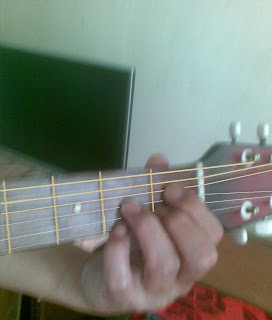In some guitar lessons these type of chords usually are not being dealt at an early stage but i chose to deal with these as early as the songs you are longing to play may not always go with just simple chords. The diminished and augmented chords are beautiful passing chords one must not treat these as optional chords to play even though when some printed songs with chords say it so. In some songs these chords come in parenthesis as it can be optionally played but you better try to play it when listed because it enriches your tone harmony hearing judgement. You enrich your chord accompaniment analization by always trying to play all even those optional chords. I want to prepare your fingers as early in playing these chords.


The important thing to remember is that the Ddim chord formation is also called the G#dim, Bdim or Fdim chord. You can practice your fingers here with some chord combinations like this: D - Ddim - Em - Bbdim - D. Do this in a two downward thumb stroke for every chord with just a single downward thumb stroke at the last chord. Here and in the following exercises below, you will start getting familiarized on how the diminished chord harmonizes with other chords.
Adim chord formation is also called the Cdim, Ebdim or F#dim chord. You can try these practice pattern: F# - Adim - G#m - Ddim - F# in a 2 downward thumb stroke for every chord and just a single downward thumb stroke at the last chord.


The Bbdim is also being called the C#dim, Edim or Gdim chord. Do this practice pattern C - Bbdim - Dm7 - Ddim - C.




The Caug chord formation is also being called as the Abaug or Eaug chord. Try to practice this chord pattern: C - Caug - F - Aaug - Dm7 - G - C.


Aaug also goes by the name as the Baug, Dbaug or Faug chord. The practice pattern goes this way: A - Aaug - D - Daug - Bm7 - E - A.


Daug is also being called the Bbaug or Gbaug chord. You can have these chords for practicing: D - Daug - G - Gaug - Em - A - D


Daug is also being called the Bbaug or Gbaug chord. You can have these chords for practicing: D - Daug - G - Gaug - Em - A - D


As for Gaug chord position, this is also called the Ebaug chord. So you can have these chords to practice: G - Gaug - C - Caug - Am - D - G. Remember, in all these exercises above you will just strum the chord twice with downward thumb stroke and the last chord with just a single downward thumb stroke. If you're going to practice any of these in countless repetitions, all of the chords are strummed twice and just do the single downward thumb stroke at the very end.


 In this style you will learn how to play the likes of some good country or folk music like "A Horse With No Name by America, "Sugar Mountain" by Neil Young, "Crazy Little Thing Called Love" by Elvis Presley and many more. When you happened to hear the original version of the music, some instrumentation or some movements may be added to the music so just stick to our strumming pattern in order not to be disoriented. The encircled portion are only shown in order for you to map it clearly where you've been through, to allow you to see the difference between strumming patterns and to acquaint your hand to strumming changes.
In this style you will learn how to play the likes of some good country or folk music like "A Horse With No Name by America, "Sugar Mountain" by Neil Young, "Crazy Little Thing Called Love" by Elvis Presley and many more. When you happened to hear the original version of the music, some instrumentation or some movements may be added to the music so just stick to our strumming pattern in order not to be disoriented. The encircled portion are only shown in order for you to map it clearly where you've been through, to allow you to see the difference between strumming patterns and to acquaint your hand to strumming changes.
































